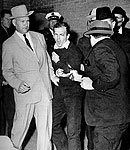A Moment Frozen in Time Then Thawed With Adobe Photoshop
One sunny afternoon in 1996, I was eating lunch and surfin' the web when I came across the Pulitzer Prize-winning photograph by Bob Jackson of Jack Ruby shooting Lee Harvey Oswald. Bob's camera certainly caught a rare moment in time–that grey area between certainty and unreality. Jack Ruby was in a posture that spoke of conviction and drive and there was something in Oswald's face-a look of passion that's hard to duplicate. The phrase "screamin' the blues"; came to mind because he looked to me like a young Rock 'n' Roller belting out a serious tune. The Photoshop bug sunk its teeth into me. 40 minutes later, my photo-illustration was born.
I have since become acquainted with Bob and his family and spent time together in Nag's Head, North Carolina to lift a glass or two and talk about photography, Dallas, and the sands of time pouring through the hourglass of history. Being in the right place at the right time, Bob captured the image of an event that riveted the nation in 1963.
Bob's photograph is familiar to most Americans, especially those who are old enough to remember the events as they unfolded on Sunday, November 24, 1963. He was there when a young man, Lee Harvey Oswald, was shot to death while handcuffed to officer Jim Leavelle as the Dallas Police were escorting him through the basement garage of the city jail. His killer, Jack Ruby, accomplished his goal with a single shot to Oswald's abdomen from a .38 special Colt Cobra pistol. Millions of people witnessed this event as it was broadcast nationwide. As I watched the broadcast, my mother exclaimed, "My God! They just shot that man!" I remember that moment quite vividly; that gut-level response. I am certain others across the land had similar reactions as the black and white images gave America a first-hand look at live, televised murder.
A young photographer, Bob Jackson, was among several photojournalists covering the transfer of Lee Oswald to the county jail facility. At 11:21 a.m., Dallas time, Bob opened the shutter of his camera and recorded a fleeting, rare moment. The image he caught, unlike the dozens of photographs and video frames of this terrible event, captured the totality of the moment on a single frame and would not have happened, had he pressed the shutter release a half-second earlier or later.
Oswald's face registers the anguish and pain produced by a bullet tearing through his abdomen and damaging nearly every organ. His arms, which had been hanging at his stomach, lurched upward across his chest. Officer Leavelle instinctively recoiled away from the report of the firearm. Jack Ruby, with the pistol thrust forward in his right hand, his left hand clenched in a fist at his side, prepared to fire a second round into Oswald. The heads of a few policemen and reporters turned toward the disturbance, others did not.
This Pulitzer Prize-winning photograph is a monument to photojournalism. It single-handedly captures that grey area which exists between reality and comprehension. When Jackson took this picture, at that precise millisecond in time, America was still simply watching television with the visual information of this event just beginning to move through their nervous systems and register in their brains. In that Dallas basement garage, only Ruby, Oswald and Leavelle had the full awareness of what was transpiring. Others around them were in the same state as the rest of the nation, unaware, but within microseconds of dawning recognition.
This trio, captured on film by his camera, are suspended in time. The three of them have become a microuniverse of cognition; a violent subset of the event of the moment that was about to erupt and envelope the consciousness of all those witnessing it and, indeed, the nation.
It is truly one of the most historic and powerful photographs of the 20th century.


